Assessment and Improvement of Two Low-Cost Particulate Matter Sensor Systems by Using Spatial Interpolation Data from Air Quality Monitoring Stations
Abstract
1. Introduction
2. Materials and Methodology
2.1. Study Area and Three Monitoring Systems
2.2. Performance Analysis of Two Low-Cost Sensor Systems
3. Results and Discussion
3.1. Monitoring Data Analysis of AQMSs
3.2. Performance Analysis of the Two Low-Cost Sensor Systems
3.3. Spatial Distribution Analysis
3.4. Outlier Detection in the Observed Data
4. Suggestions for Improvements
4.1. Monitoring Operation Loop
4.1.1. Cluster Attributes
4.1.2. ODM (Outlier Detection Module)
4.1.3. TAAM (Temporal Anomaly Analysis Module)
4.1.4. SAAM (Spatial Anomaly Analysis Module)
4.1.5. STAAM (Spatiotemporal Anomaly Analysis Module)
4.1.6. TRAJM (Trajectory Analysis Module)
4.2. Automatic Correction Loop
4.2.1. SIM (Spatial Interpolation Module)
4.2.2. SPDM (Sensor Performance Detection Module)
4.2.3. CM (Correction Module)
5. Conclusions
Author Contributions
Funding
Institutional Review Board Statement
Informed Consent Statement
Data Availability Statement
Acknowledgments
Conflicts of Interest
Abbreviations
| Abbreviation | Full words |
| AQMSs | Air quality monitoring stations |
| CM | Correction module |
| IDW | Inverse distance weighting |
| MANGE | Mean absolute normalized gross error |
| PMSs | Particulate monitor sensors |
| SAAM | Spatial anomaly analysis module |
| SPDM | Sensor performance detection module |
| TAAM | Temporal anomaly analysis module |
| ARRF | Average relative response factor |
| EPA | Environmental Protection Administration |
| IoT | Internet of Things |
| ODM | Outlier detection module |
| QGIS | Quantum Geographic Information System |
| SIM | Spatial interpolation module |
| STAAM | Spatiotemporal anomaly analysis module |
| TRAJM | Trajectory analysis module |
References
- Lee, C.H.; Wang, Y.B.; Yu, H.L. An efficient spatiotemporal data calibration approach for the low-cost PM2.5 sensing network: A case study in Taiwan. Environ. Int. 2019, 130, 104838. [Google Scholar] [CrossRef] [PubMed]
- Karagulian, F.; Barbiere, M.; Kotsev, A.; Spinelle, L.; Gerboles, M.; Lagler, F.; Redon, N.; Crunaire, S.; Borowiak, A. Review of the performance of low-cost sensors for air quality monitoring. Atmosphere 2019, 10, 506. [Google Scholar] [CrossRef]
- Rogulski, M. Low-cost PM monitors as an opportunity to increase the spatiotemporal resolution of measurements of air quality. Energy Procedia 2017, 128, 437–444. [Google Scholar] [CrossRef]
- Gao, M.; Cao, J.; Seto, E. A distributed network of low-cost continuous reading sensors to measure spatiotemporal variations of PM2.5 in Xi’an, China. Environ. Pollut. 2015, 199, 56–65. [Google Scholar] [CrossRef] [PubMed]
- Heimann, I.; Bright, V.B.; McLeod, M.W.; Mead, M.I.; Popoola, O.A.M.; Stewart, G.B.; Jones, R.L. Source attribution of air pollution by spatial scale separation using high spatial density networks of low cost air quality sensors. Atmos. Environ. 2015, 113, 10–19. [Google Scholar] [CrossRef]
- Williams, R.; Duvall, R.; Kilaru, V.; Hagler, G.; Hassinger, L.; Benedict, K.; Rice, J.; Kaufman, A.; Judge, R.; Pierce, G.; et al. Deliberating performance targets workshop: Potential paths for emerging PM2.5 and O3 air sensor progress. Atmos. Environ. 2019, X2, 100031. [Google Scholar] [CrossRef]
- Moltchanov, S.; Levy, I.; Etzion, Y.; Lerner, U.; Broday, D.M.; Fishbain, B. On the feasibility of measuring urban air pollution by wireless distributed sensor networks. Sci. Total Environ. 2015, 502, 537–547. [Google Scholar] [CrossRef] [PubMed]
- Kanabkaew, T.; Mekbungwan, P.; Raksakietisak, S.; Kanchanasut, K. Detection of PM2.5 plume movement from IoT ground level monitoring data. Environ. Pollut. 2019, 252, 543–552. [Google Scholar] [CrossRef]
- Lung, S.C.C.; Wang, W.C.V.; Wen, T.Y.J.; Liu, C.H.; Hu, S.C. A versatile low-cost sensing device for assessing PM2.5 spatiotemporal variation and quantifying source contribution. Sci. Total Environ. 2020, 716, 137145. [Google Scholar] [CrossRef] [PubMed]
- Judge, R.; Wayland, R.A. Regulatory considerations of lower cost air pollution sensor data performance. EM Air Waste Manag. Assoc. Mag. Environ. Manag. 2014, 32–37. Available online: https://cfpub.epa.gov/si/si_public_record_report.cfm?Lab=ORA&dirEntryId=289472 (accessed on 1 February 2021).
- Zheng, T.; Bergin, M.H.; Johnson, K.K.; Tripathi, S.N.; Shirodkar, S.; Landis, M.S.; Sutaria, R.; Carlson, D.E. Field evaluation of low-cost particulate matter sensors in high- and low-concentration environments. Atmos. Meas. Tech. 2018, 11, 4823–4846. [Google Scholar] [CrossRef]
- Rai, A.C.; Kumar, P.; Pilla, F.; Skouloudis, A.N.; Sabatino, S.D.; Ratti, C.; Yasar, A.; Rickerby, D. End-user perspective of low-cost sensors for outdoor air pollution monitoring. Sci. Total Environ. 2017, 607–608, 691–705. [Google Scholar] [CrossRef]
- Borrego, C.; Costa, A.M.; Ginja, J.; Amorim, M.; Coutinho, M.; Karatzas, K.; Sioumis, T.; Katsifarakis, N.; Konstantinidis, K.; De Vito, S.; et al. Assessment of air quality microsensors versus reference methods: The EuNetAir joint exercise. Atmos. Environ. 2016, 147, 246–263. [Google Scholar] [CrossRef]
- Holstius, D.M.; Pillarisetti, A.; Smith, K.R.; Seto, E. Field calibrations of a low cost aerosol sensor at a regulatory monitoring site in California. Atmos. Meas. Tech. 2014, 7, 1121–1131. [Google Scholar] [CrossRef]
- Lin, Y.C.; Chi, W.J.; Lin, Y.Q. The improvement of spatial-temporal resolution of PM2.5 estimation based on micro-air quality sensors by using data fusion technique. Environ. Int. 2020, 134, 105305. [Google Scholar] [CrossRef] [PubMed]
- Manikonda, A.; Zíková, N.; Hopke, P.K.; Ferro, A.R. Laboratory assessment of low-cost PM monitors. J. Aerosol Sci. 2016, 102, 29–40. [Google Scholar] [CrossRef]
- Sayahi, T.; Butterfield, A.; Kelly, K.E. Long-term field evaluation of the Plantower PMS low-cost particulate matter sensors. Environ. Pollut. 2019, 245, 932–940. [Google Scholar] [CrossRef]
- Clementsa, A.L.; Reece, S.; Conner, T.; Williams, R. Observed data quality concerns involving low-cost air sensors. Atmos. Environ. 2019, X3, 100034. [Google Scholar] [CrossRef]
- Kelly, K.E.; Whitaker, J.; Petty, A.; Widmer, C.; Dybwad, A.; Sleeth, D.; Martin, R.; Butterfield, A. Ambient and laboratory evaluation of a low-cost particulate matter sensor. Environ. Pollut. 2017, 221, 491–500. [Google Scholar] [CrossRef]
- Williams, D.E. Low cost sensor networks: How do we know the data are reliable? ACS Sens. 2019, 4, 2558–2565. [Google Scholar] [CrossRef]
- Miskell, G.; Salmond, J.A.; William, D.E. Solution to the problem of calibration of low-cost air quality measurement sensors in networks. ACS Sens. 2018, 3, 832–843. [Google Scholar] [CrossRef] [PubMed]
- Weissert, L.; Miles, E.; Miskell, G.; Alberti, K.; Feenstra, B.; Henshaw, G.S.; Papapostolou, V.; Patel, H.; Polidori, A.; Salmond, J.A.; et al. Hierarchical network design for nitrogen dioxide measurement in urban environments. Atmos. Environ. 2020, 228, 117428. [Google Scholar] [CrossRef]
- Weissert, L.; Alberti, K.; Miles, E.; Miskell, G.; Feenstra, B.; Henshaw, G.S.; Papapostolou, V.; Patel, H.; Polidori, A.; Salmond, J.A.; et al. Low-cost sensor networks and land-use regression: Interpolating nitrogen dioxide concentration at high temporal and spatial resolution in Southern California. Atmos. Environ. 2020, 223, 117287. [Google Scholar] [CrossRef]
- Gray, J. Quantum GIS: The open-source geographic information system. Linux J. 2008, 8. Available online: https://www.linuxjournal.com/magazine/quantum-gis-open-source-geographic-information-system (accessed on 1 February 2021).
- Youn, J.S.; Han, S.; Yi, J.S.; Kang, D.I.; Jang, K.W.; Jung, Y.W.; Parkd, Y.K.; Jeonb, K.J. Development of PM10 and PM2.5 cyclones for small sampling ports at stationary sources: Numerical and experimental study. Environ. Res. 2021, 193, 110507. [Google Scholar] [CrossRef] [PubMed]
- Hong, P.; Phoebe, A.D.; Jones, M.D. Study of relative response factors and mass balance in forceddegradation studies with liquid chromatography/photo-diode array detector/evaporative light scattering detector/mass spectrometry system. J. Chromatogr. A 2017, 1512, 61–67. [Google Scholar] [CrossRef]
- Schneider, P.; Castell, N.; Vogt, M.; Dauge, F.R.; Lahoz, W.A.; Bartonova, A. Mapping urban air quality in near real-time using observations from low cost sensors and model information. Environ. Int. 2017, 106, 234–247. [Google Scholar] [CrossRef] [PubMed]
- Lim, C.C.; Kim, H.; Ruzmyn Vilcassim, M.J.; Thurston, G.D.; Gordon, T.; Chen, L.C.; Lee, K.; Heimbinder, M.; Kim, S.Y. Mapping urban air quality using mobile sampling with low-cost sensors and machine learning in Seoul, South Korea. Environ. Int. 2019, 131, 105022. [Google Scholar] [CrossRef] [PubMed]
- Shukla, K.; Kumar, P.; Mann, G.S.; Khare, M. Mapping spatial distribution of particulate matter using Kriging and inverse distance weighting at supersites of megacity Delhi. Sustain. Cities Soc. 2020, 54, 101997. [Google Scholar] [CrossRef]
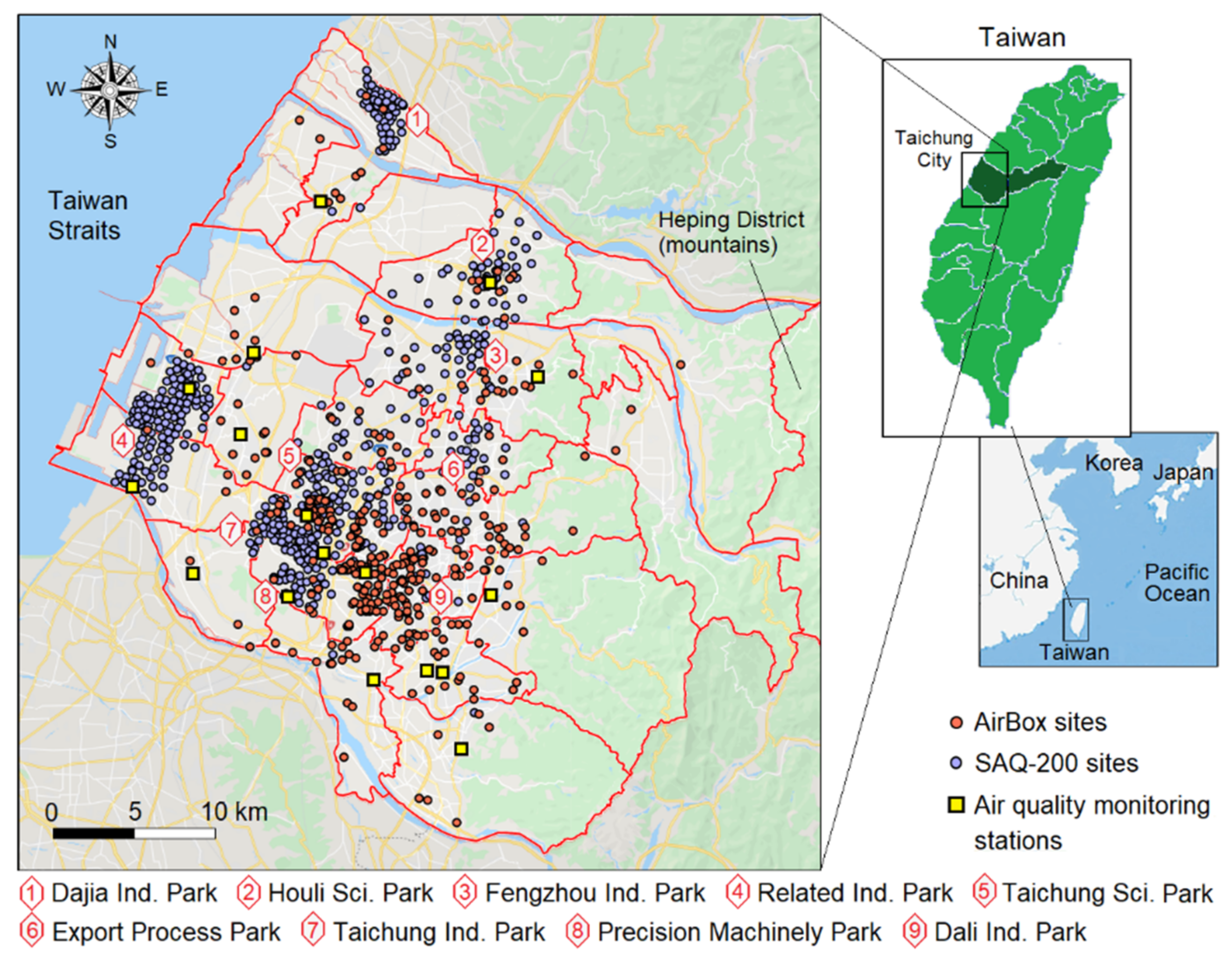
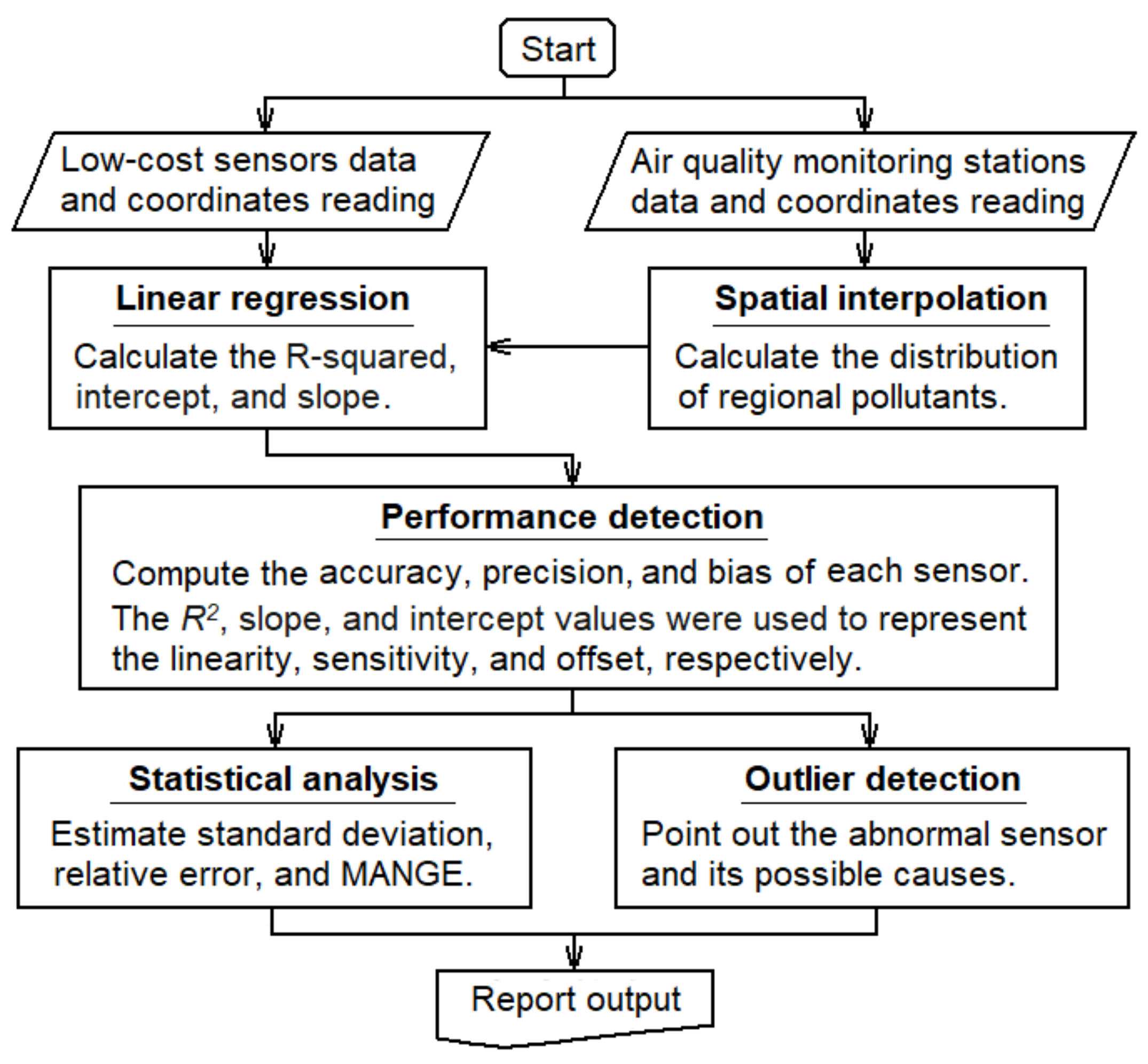
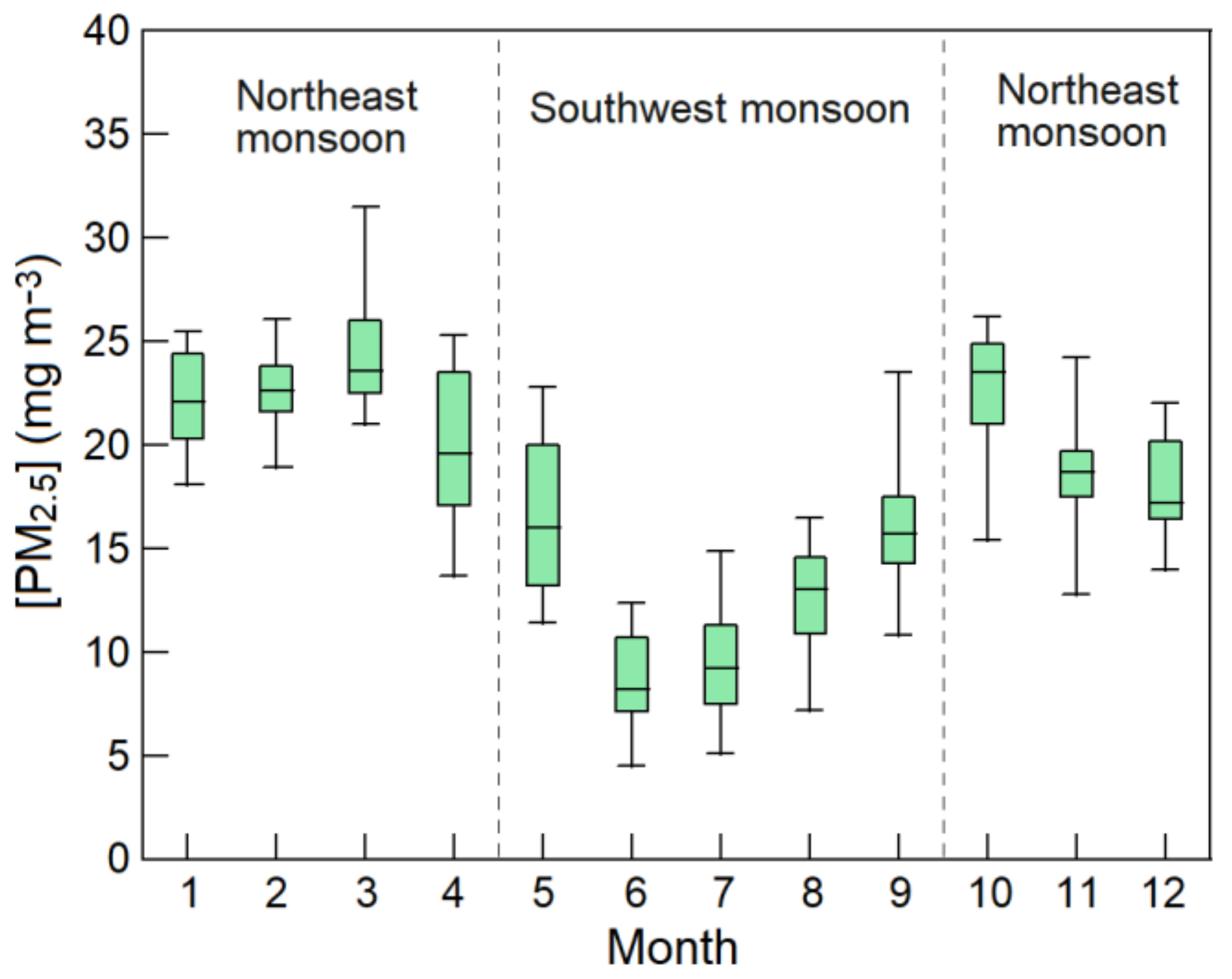
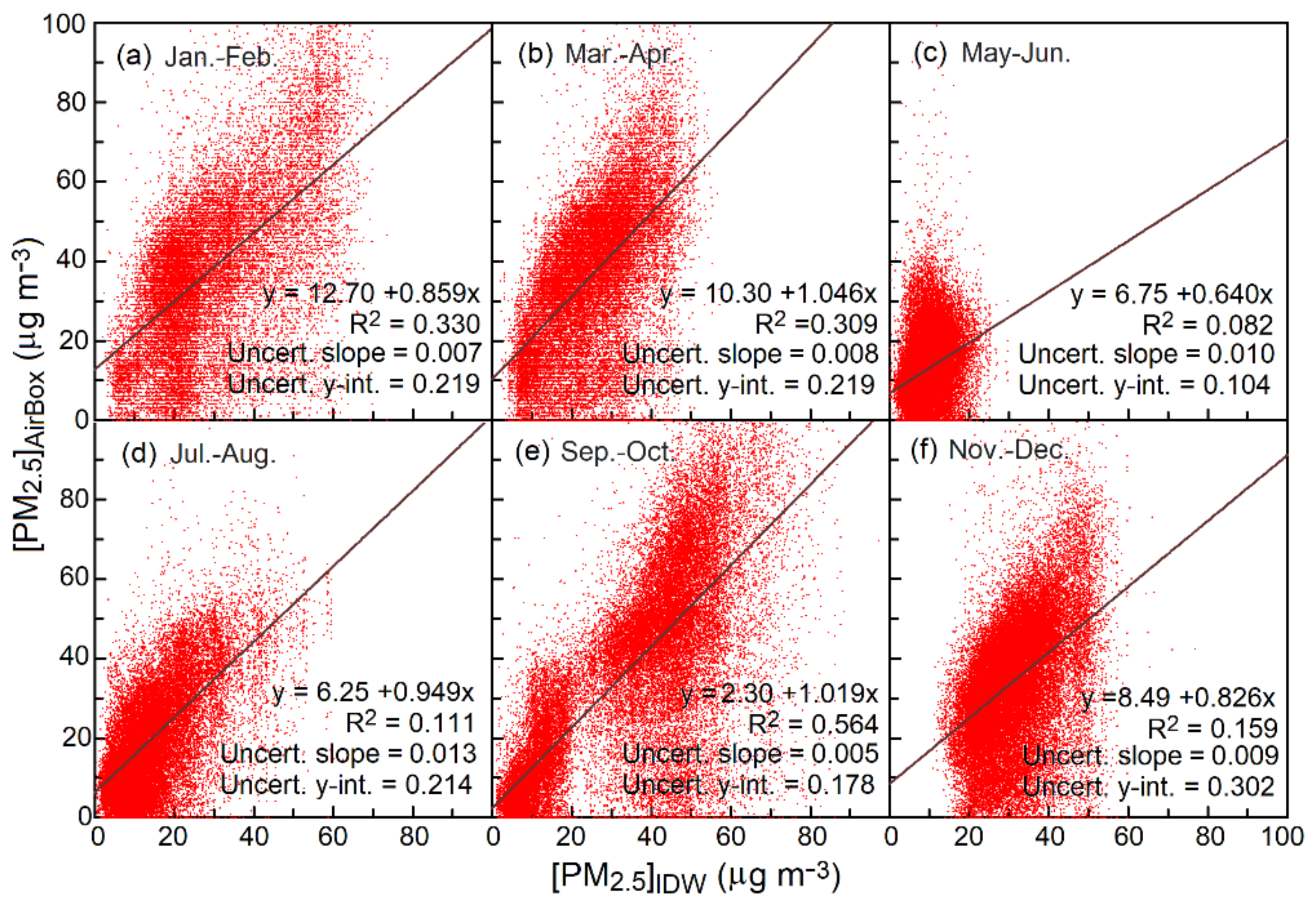
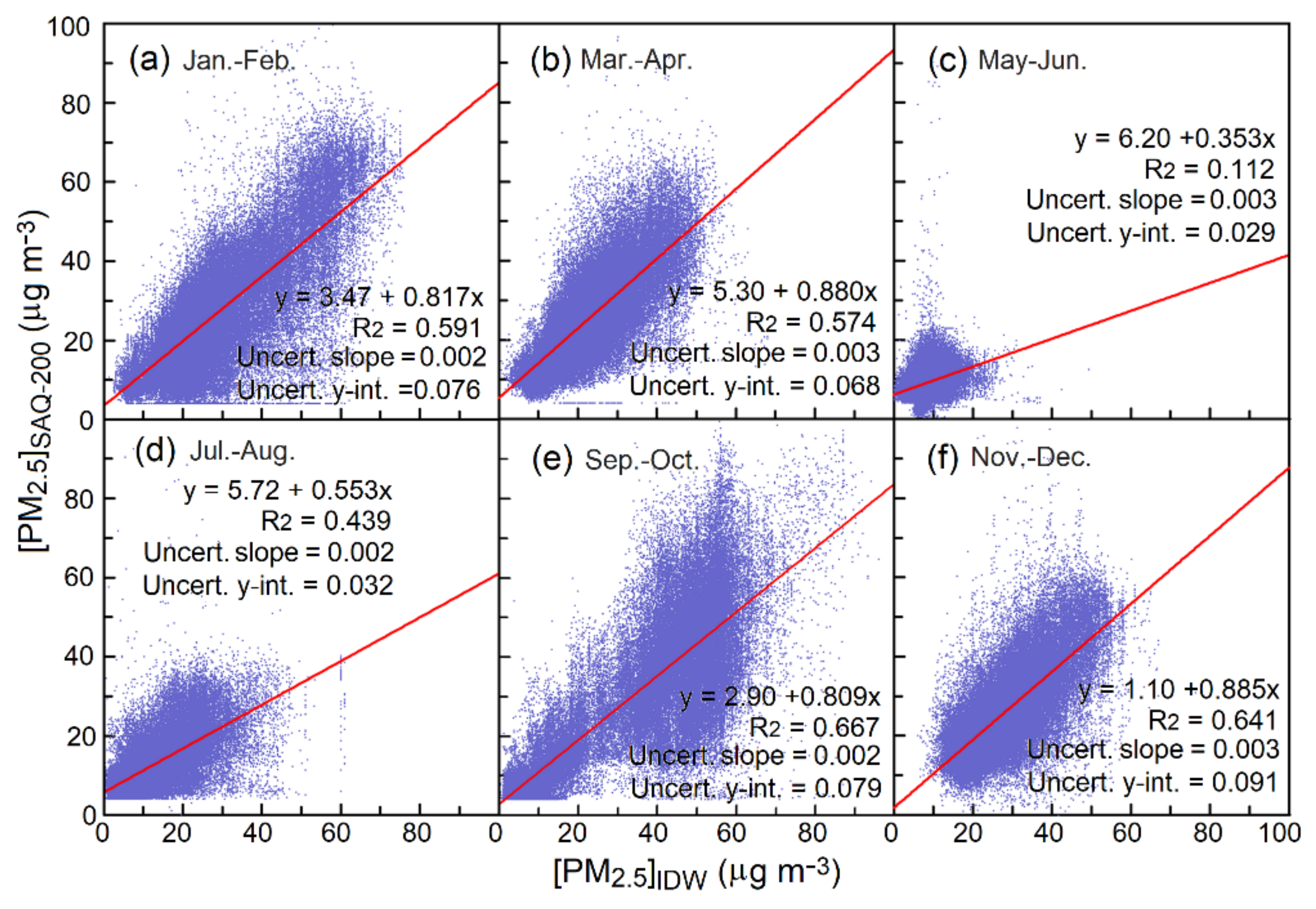
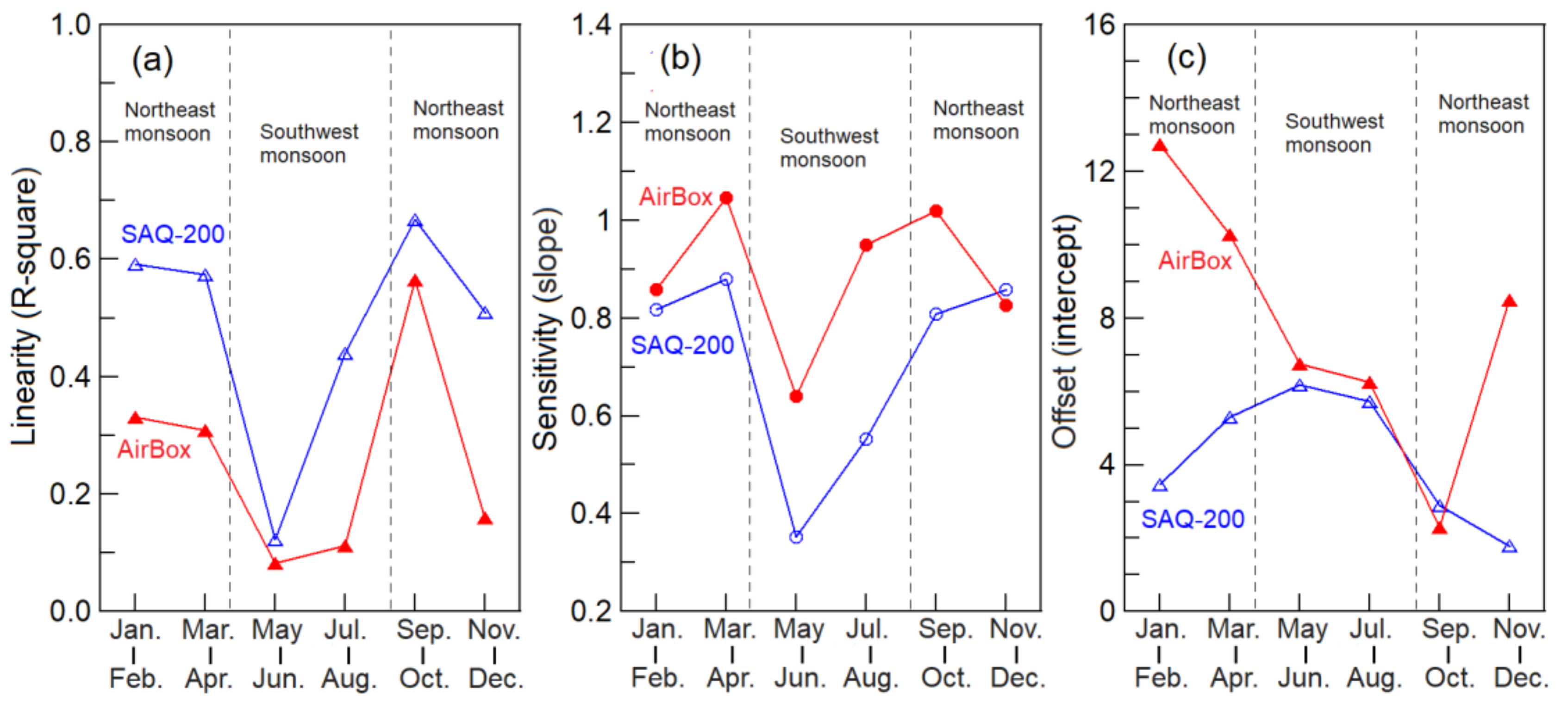
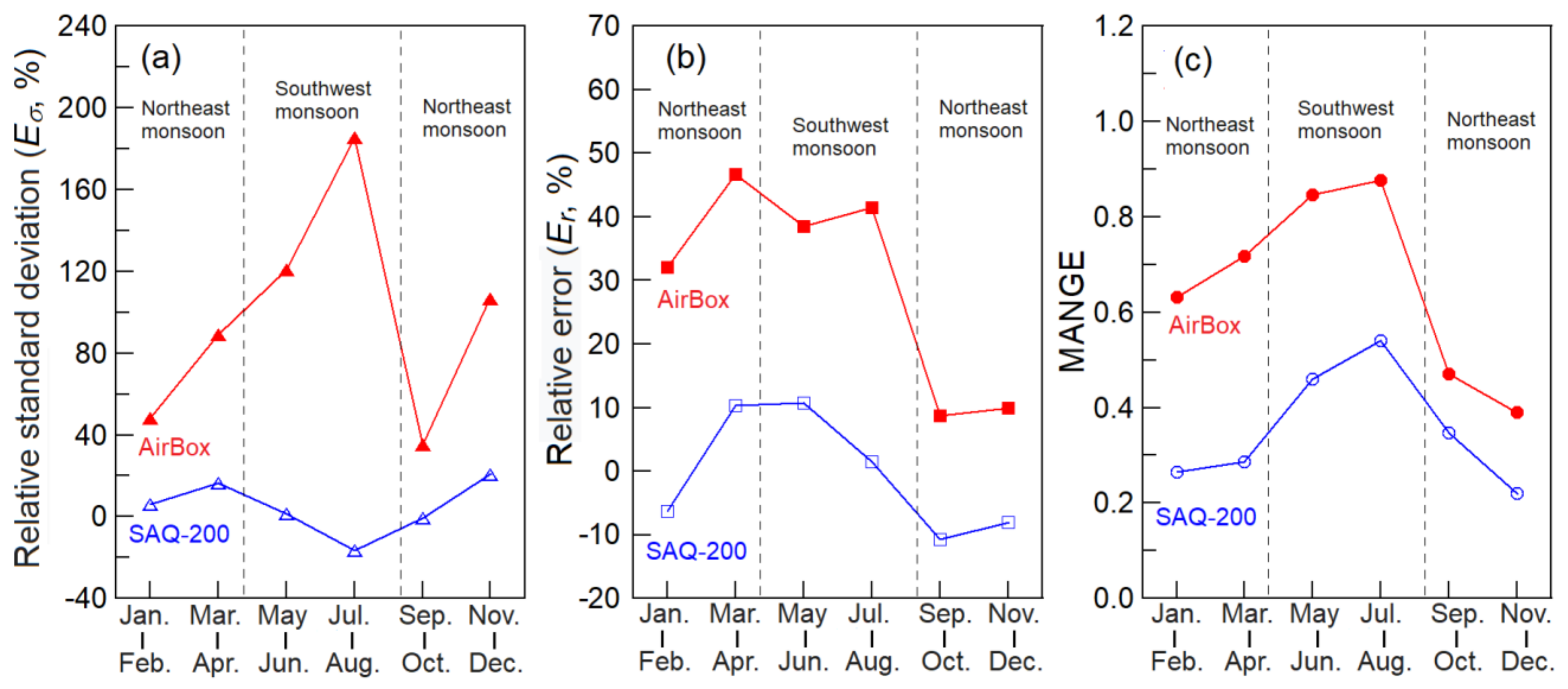
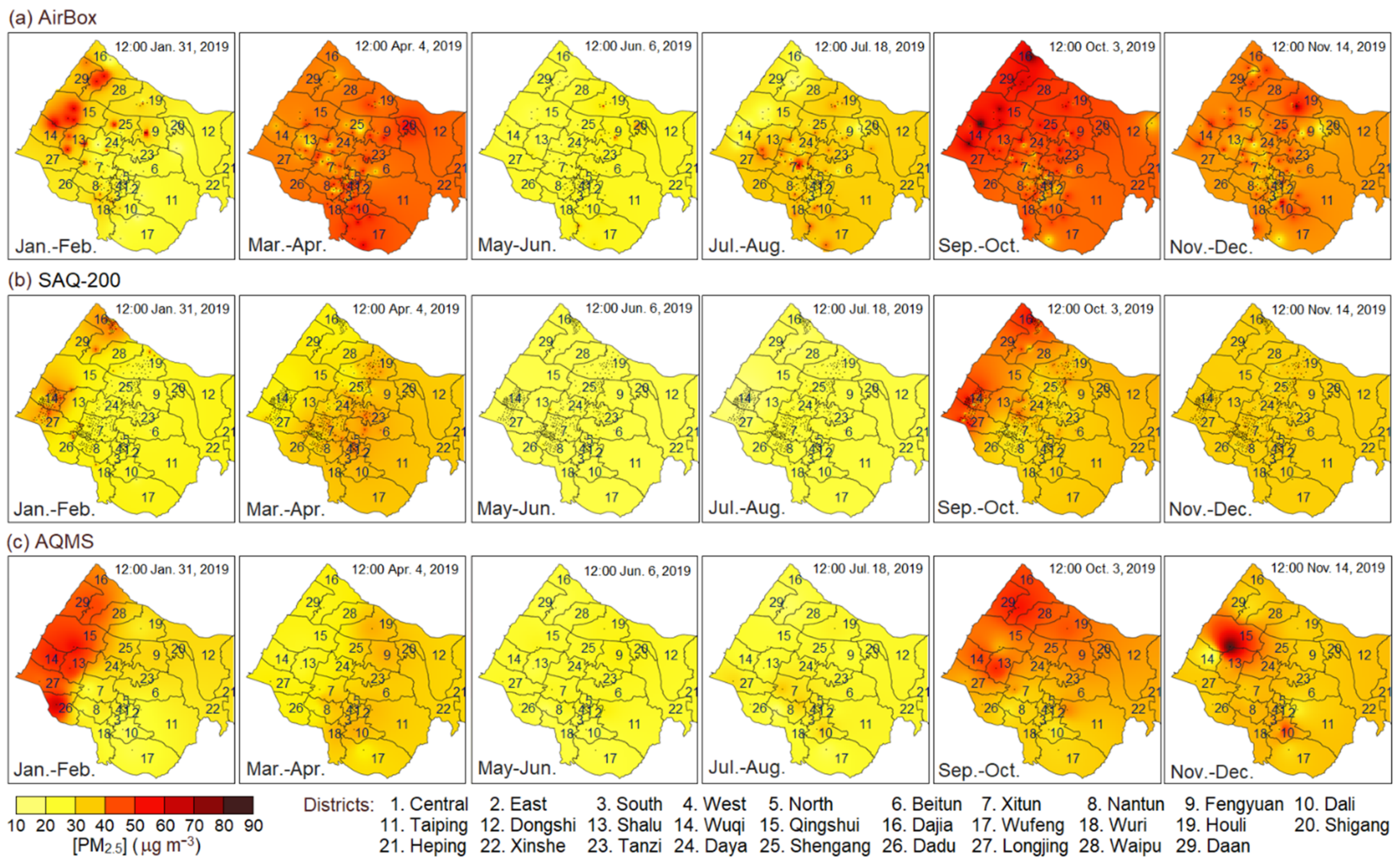
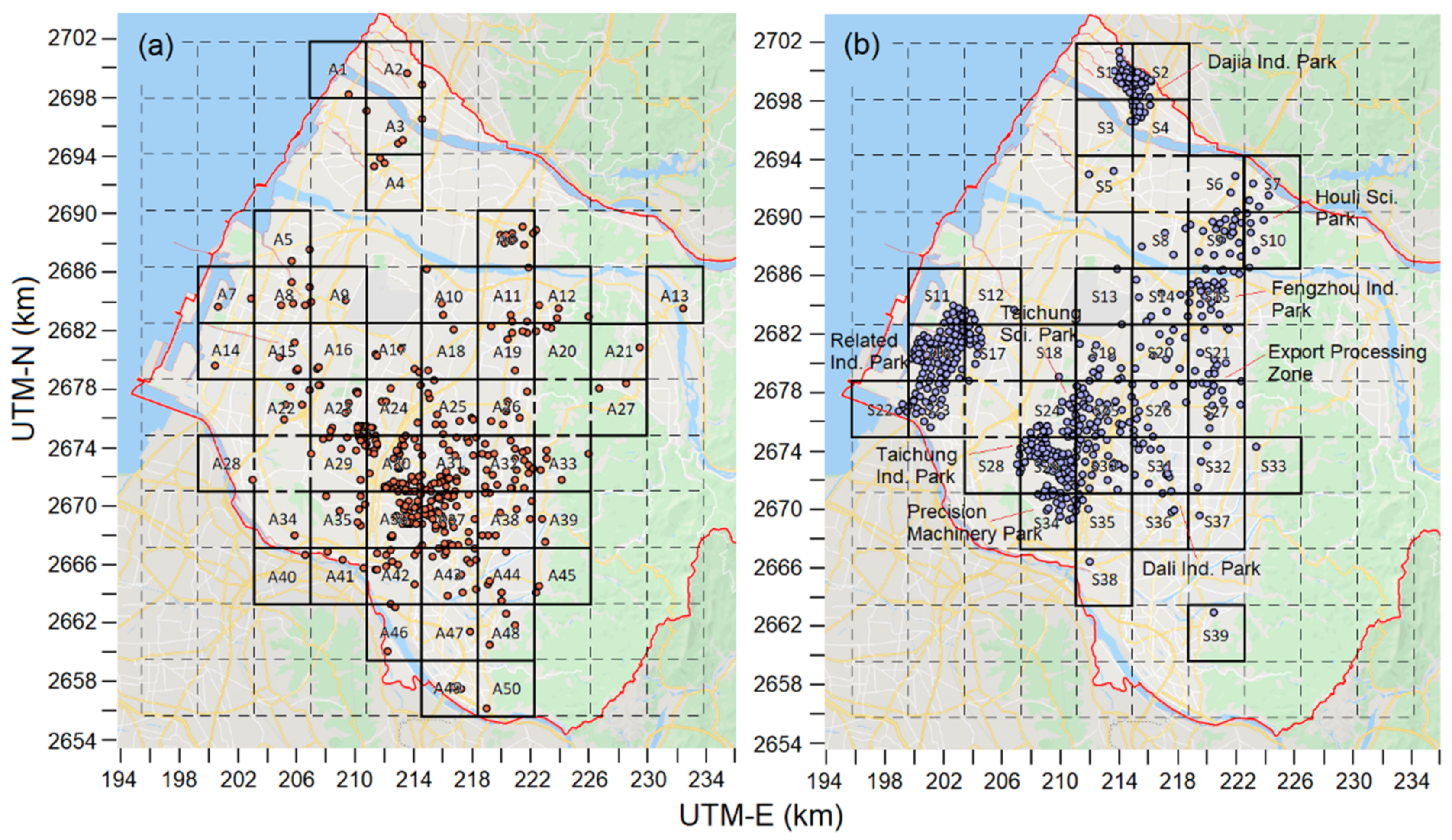

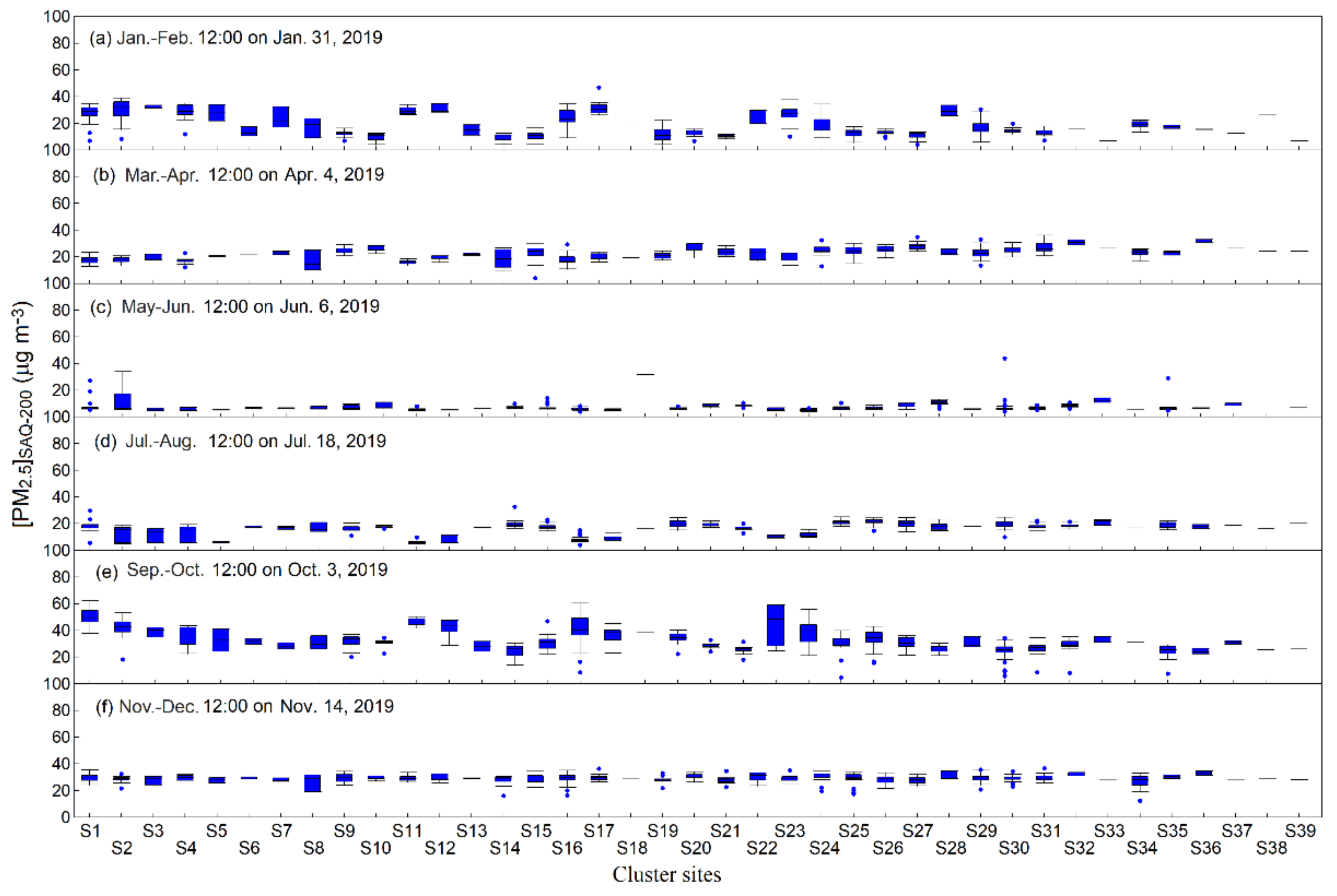
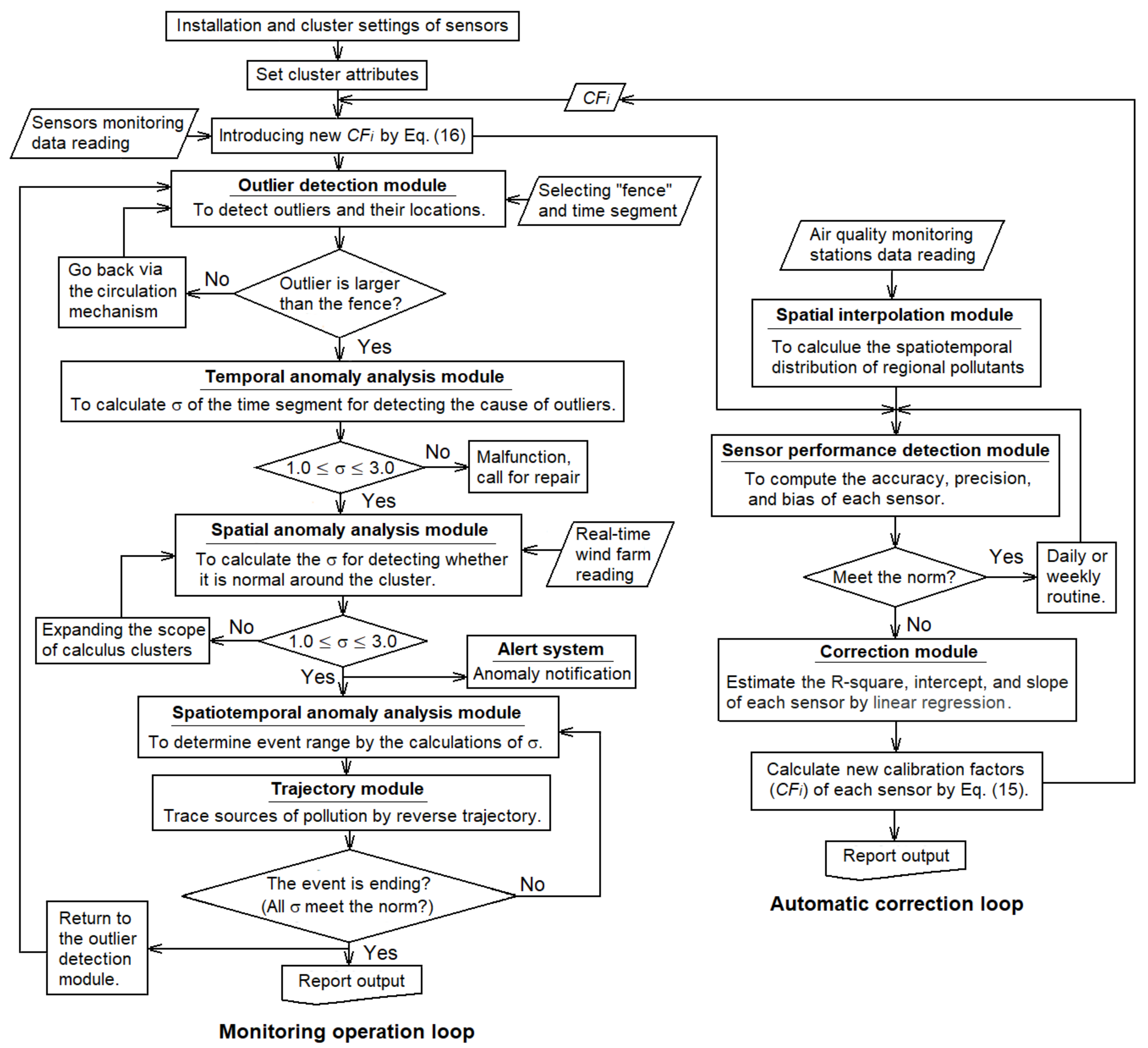
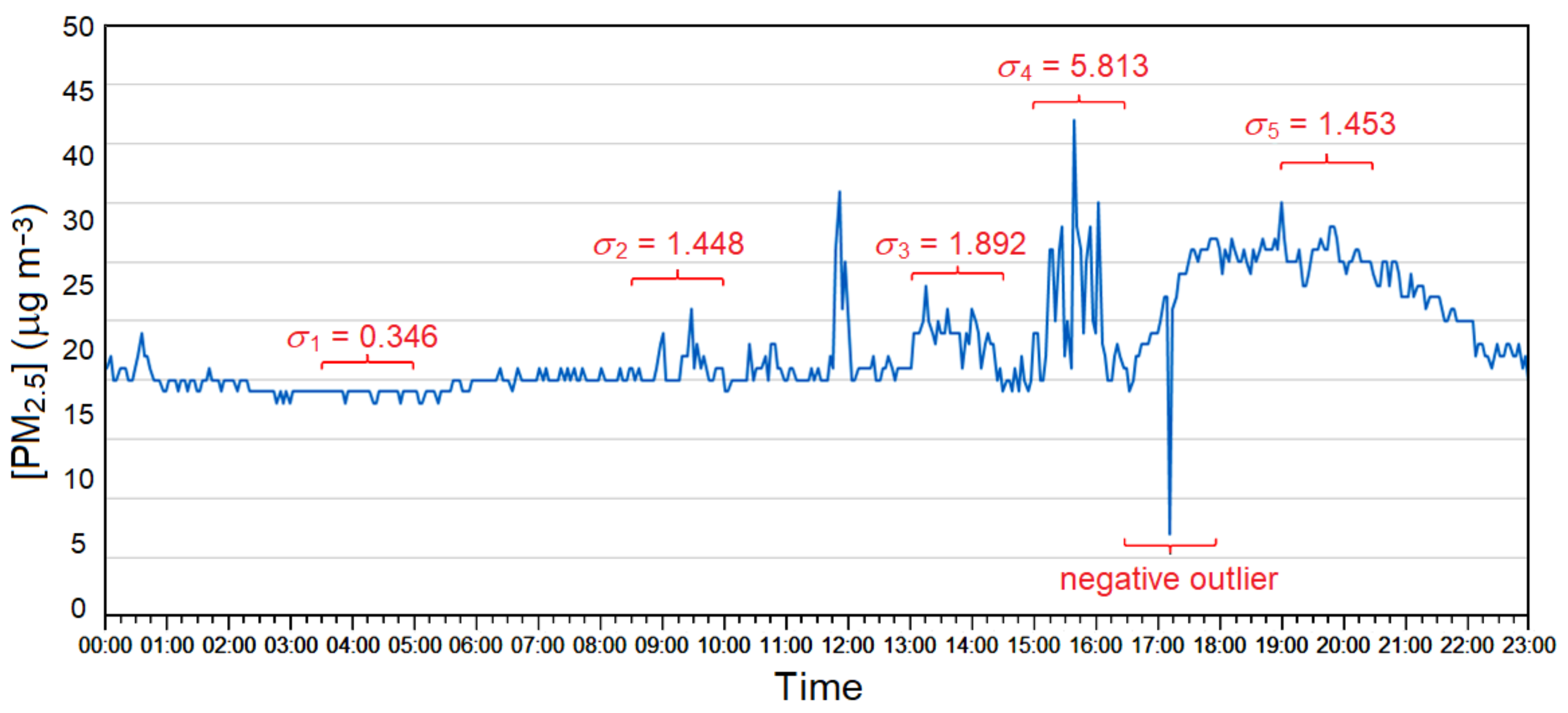
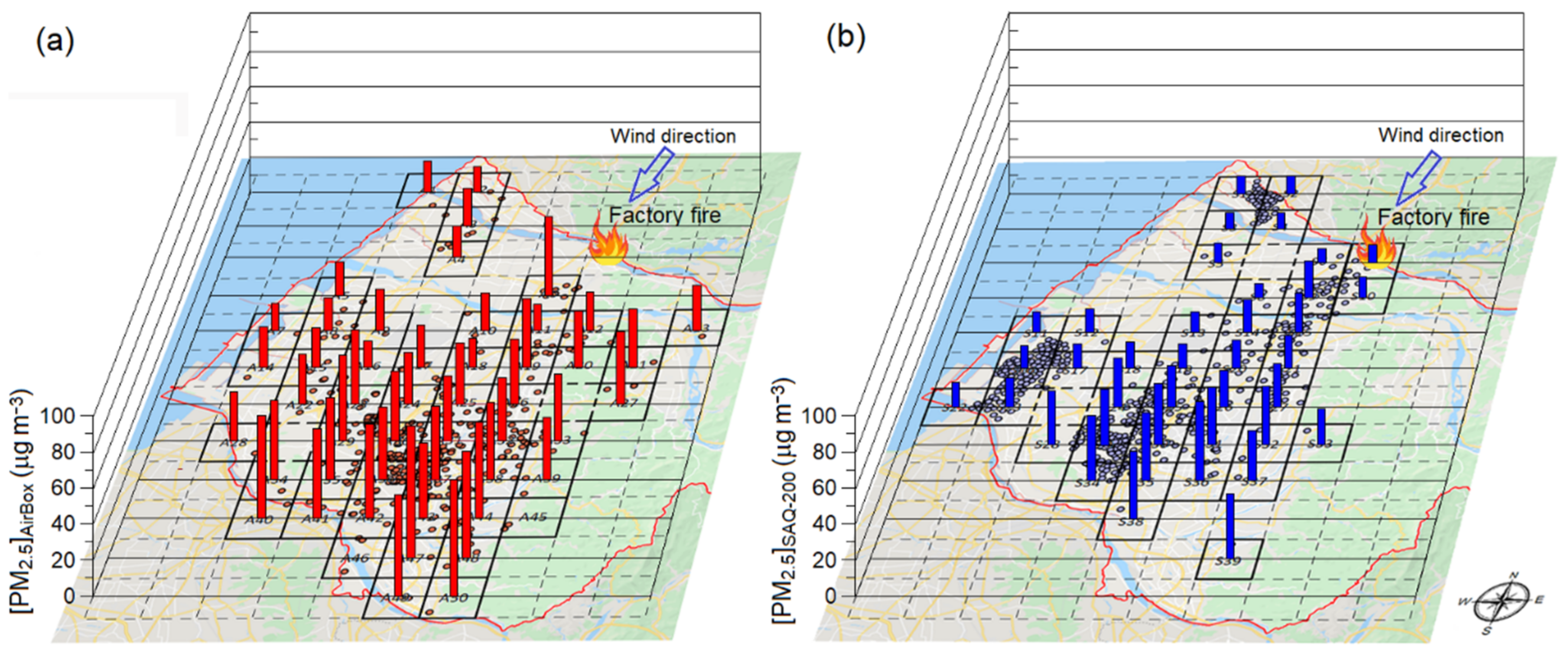
| Items | Period 1 | Period 2 | Period 3 | Period 4 | Period 5 | Period 6 |
|---|---|---|---|---|---|---|
| AirBox sensors | ||||||
| Number of outliers | 5 | 4 | 8 | 8 | 3 | 9 |
| Number of valid observations | 179 | 208 | 250 | 249 | 221 | 245 |
| Outlier rate (%) | 2.8 | 1.9 | 3.2 | 3.2 | 1.4 | 3.7 |
| Min fence (μg m−3) | −21.9–44.8 | −2.8−44.8 | −15.9−11.7 | −23.2−26.6 | −2.0−44.5 | −15.1−36.9 |
| Max fence (μg m−3) | 15.3−59.1 | 45.8−74.1 | 8.7−38.1 | 17.2−64.9 | 47.3−85.3 | 44.6−88.3 |
| Average fence (μg m−3) | 5.4−40.4 | 18.2−59.0 | 2.8−23.8 | 9.5−48.1 | 19.7−62.6 | 14.0−58.3 |
| SAQ-200 sensors | ||||||
| Number of outliers | 14 | 9 | 33 | 24 | 25 | 26 |
| Number of valid observations | 488 | 492 | 492 | 486 | 480 | 487 |
| Outlier rate (%) | 2.9 | 1.8 | 6.7 | 4.9 | 5.2 | 5.3 |
| Min fence (μg m−3) | −13.2−29.6 | −6.3−21.4 | −1.45−8.4 | −10.7−18.0 | −3.2−37.6 | 14.1−29.0 |
| Max fence (μg m−3) | 13.2−52.2 | 19.9−43.7 | 6.3−18.0 | 7.4−34.1 | 26.9−80.8 | 30.1−40.9 |
| Average fence (μg m−3) | 11.2−27.2 | 14.5−29.0 | 4.7−9.0 | 10.8−20.9 | 22.8−43.7 | 23.6−34.8 |
Publisher’s Note: MDPI stays neutral with regard to jurisdictional claims in published maps and institutional affiliations. |
© 2021 by the authors. Licensee MDPI, Basel, Switzerland. This article is an open access article distributed under the terms and conditions of the Creative Commons Attribution (CC BY) license (http://creativecommons.org/licenses/by/4.0/).
Share and Cite
Liang, C.-J.; Yu, P.-R. Assessment and Improvement of Two Low-Cost Particulate Matter Sensor Systems by Using Spatial Interpolation Data from Air Quality Monitoring Stations. Atmosphere 2021, 12, 300. https://doi.org/10.3390/atmos12030300
Liang C-J, Yu P-R. Assessment and Improvement of Two Low-Cost Particulate Matter Sensor Systems by Using Spatial Interpolation Data from Air Quality Monitoring Stations. Atmosphere. 2021; 12(3):300. https://doi.org/10.3390/atmos12030300
Chicago/Turabian StyleLiang, Chen-Jui, and Pei-Rong Yu. 2021. "Assessment and Improvement of Two Low-Cost Particulate Matter Sensor Systems by Using Spatial Interpolation Data from Air Quality Monitoring Stations" Atmosphere 12, no. 3: 300. https://doi.org/10.3390/atmos12030300
APA StyleLiang, C.-J., & Yu, P.-R. (2021). Assessment and Improvement of Two Low-Cost Particulate Matter Sensor Systems by Using Spatial Interpolation Data from Air Quality Monitoring Stations. Atmosphere, 12(3), 300. https://doi.org/10.3390/atmos12030300






